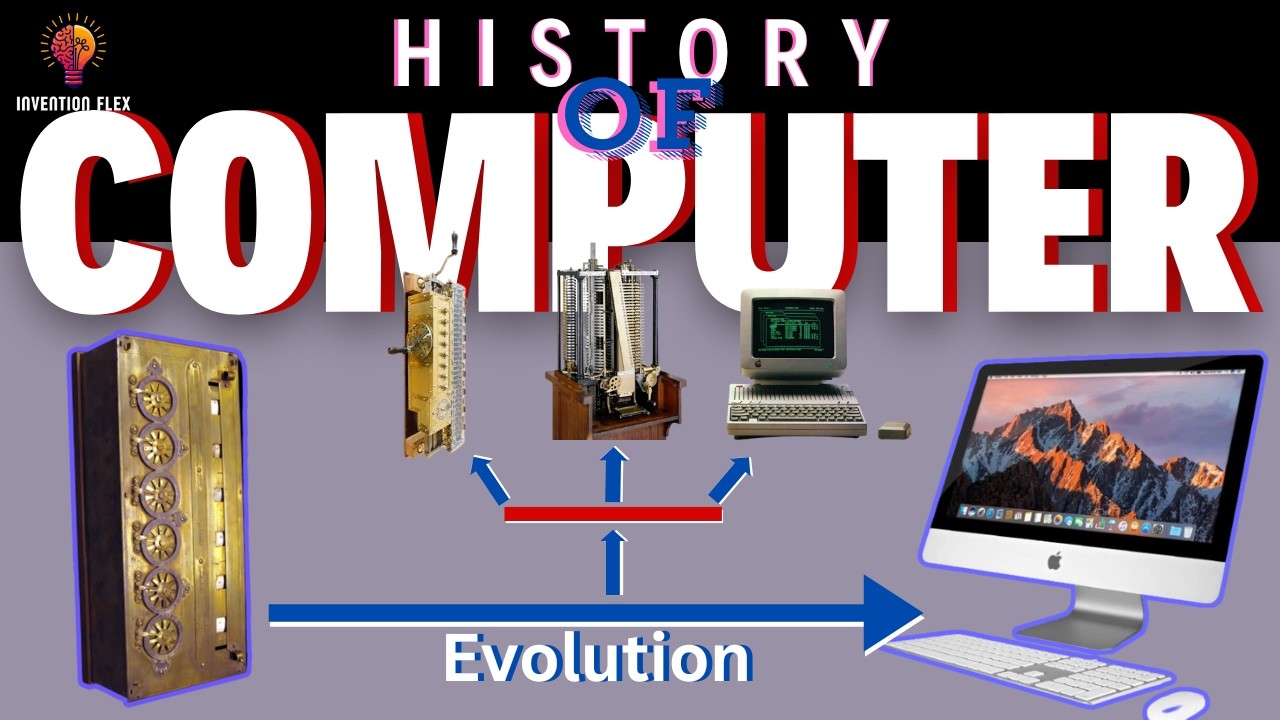Como surgiu o computador: Conheça a história da computação!!!
Summary
TLDRIn this video, Neto takes viewers on a journey through the history of computing, tracing its evolution from simple counting tools like the abacus to the powerful digital computers of today. The video highlights key developments, including mechanical calculators, the invention of the difference engine by Charles Babbage, and the creation of early electronic machines. It also explores the impact of computing on industries, especially during the pandemic, showing how it enables remote work, healthcare innovations, and rapid problem-solving. Neto reflects on how computing continues to evolve and speculates on the future, including the potential of quantum computing.
Takeaways
- 😀 The video introduces the history of computing, emphasizing how it evolved from simple counting machines to modern computers.
- 😀 The importance of computing in today's world is highlighted, with examples like remote work, virtual communication, and online shopping.
- 😀 Computing has revolutionized industries, from aviation and banking to healthcare, enhancing efficiency, speed, and access to information.
- 😀 The history of computing is closely tied to the history of mathematics, with early devices like the abacus used to perform basic calculations.
- 😀 The abacus, invented around 2500 BC, was one of the first tools for computation, allowing for addition and subtraction through a system of beads.
- 😀 Charles Babbage is recognized as a key figure in early computing history, having designed the Difference Engine and Analytical Engine, which laid the foundation for modern computers.
- 😀 The development of mechanical devices like the astrolabe and the slide rule contributed to more efficient calculations and increased computational capacity.
- 😀 The term 'computer' originally referred to human beings who performed calculations, not machines, until the 19th century.
- 😀 Herman Hollerith's invention of the punched card machine in the 1880 census revolutionized data processing by speeding up calculations and making them more accurate.
- 😀 The rise of digital computers came from the limitations of mechanical devices, leading to the creation of machines that could store and represent values digitally, marking a major step in the evolution of computing.
Q & A
What is the main focus of the video?
-The video focuses on the history of computing, explaining how we transitioned from simple counting devices to modern computers that enable activities like gaming, video calls, and social media access.
What role did the Industrial Revolution play in the evolution of computing?
-The Industrial Revolution allowed for the mass production of goods, making processes more efficient and reducing costs. Similarly, computing has revolutionized tasks that were once manual, enabling faster and more efficient results in various fields.
How has computing become even more essential during the COVID-19 pandemic?
-During the pandemic, computing became crucial for remote work, staying connected with family and friends, ordering food through delivery apps, and even advancing the study and creation of vaccines, such as through telemedicine and virtual therapy.
What does 'computing' mean in the context of early human society?
-In the context of early human society, 'computing' referred to performing calculations, such as counting food supplies or dividing them equally among tribe members.
What was the first computing device mentioned in the video?
-The first computing device mentioned is the abacus, invented around 2500 BC in Mesopotamia. It allowed users to represent values and perform basic mathematical operations like addition and subtraction.
What was the challenge presented by the abacus in the video?
-The challenge was to determine the largest number that could be represented using the abacus and how to increase its counting capacity. The largest number possible was 9999, and adding more lines to the abacus could increase its capacity.
How did Charles Babbage contribute to the development of computing?
-Charles Babbage designed the Difference Engine and later the Analytical Engine, both mechanical computing devices. The Difference Engine could calculate polynomials, while the Analytical Engine was a more advanced general-purpose computer, featuring memory and programmable instructions.
What issue arose during the U.S. census of 1880, and how was it resolved?
-The 1880 census took seven years to complete and was outdated by the time it finished. Herman Hollerith saw this as an opportunity to develop a machine that used punched cards to speed up data processing. His invention led to the creation of IBM.
What were the limitations of early mechanical and electromechanical computers?
-Early mechanical computers had limitations in terms of the number of values they could represent, and mechanical parts wore out over time, causing errors. Electromechanical machines also had problems with punched cards, which were perishable and could lead to inaccurate data.
What technological evolution in computers does the video hint at for the future?
-The video hints at the future potential of quantum computing, suggesting that it might address the limitations of current computing systems and meet growing demands for more powerful technology.
Outlines

This section is available to paid users only. Please upgrade to access this part.
Upgrade NowMindmap

This section is available to paid users only. Please upgrade to access this part.
Upgrade NowKeywords

This section is available to paid users only. Please upgrade to access this part.
Upgrade NowHighlights

This section is available to paid users only. Please upgrade to access this part.
Upgrade NowTranscripts

This section is available to paid users only. Please upgrade to access this part.
Upgrade NowBrowse More Related Video

Os COMPUTADORES eram PESSOAS! #SagaDosComputadores Ep.1

The Untold Story of Programming

कंप्यूटर का आविष्कार कब और किसने किया ? HISTORY AND INVENTION OF COMPUTER.

History Of Computer | Full History And Evolution Of Computers Till Date

Historia y evolución de la computadora

LITE111 Week 3 - History of Computer
5.0 / 5 (0 votes)